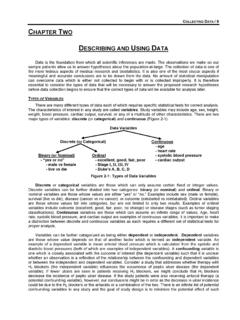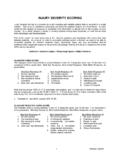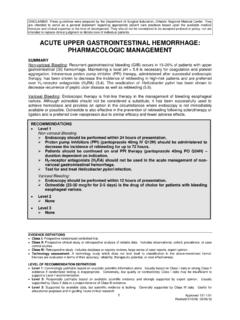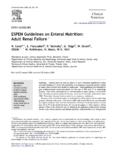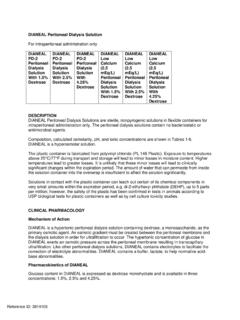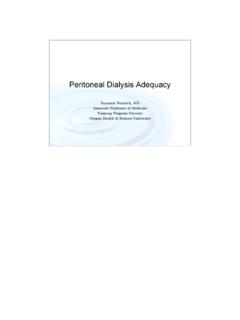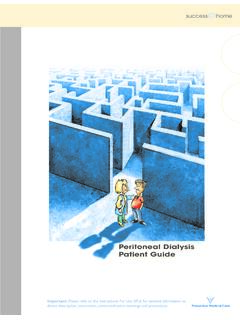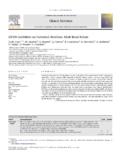Transcription of ICU ENTERAL FEEDING GUIDELINES - SurgicalCriticalCare.net
1 DISCLAIMER: These GUIDELINES are intended to serve as a general statement regarding appropriate patient care practices based upon the available medical literature and clinical expertise at the time of development. They should not be considered to be accepted protocol or policy, nor are intended to replace clinical judgment or dictate care of individual patients. ICU ENTERAL FEEDING GUIDELINES . Initiation of FEEDING 1. Ventilated patients should receive an orogastric tube (OGT), nasogastric tube (NGT) or Dobhoff tube (DHT). The correct position of the tube should be confirmed by auscultation and KUB. Patients at high risk for aspiration should receive small bowel FEEDING access. For patients requiring chronic ENTERAL nutrition support, FEEDING access should be obtained as per the physician's discretion.
2 2. ENTERAL FEEDING should be initiated within 12-24 hours of admission to ICU, unless the patient is not hemodynamically stable, adequately resuscitated, or the gastrointestinal (GI) tract is believed to be non-functioning. Patients with recent abdominal surgeries require prior discussion with the surgeon before commencing ENTERAL FEEDING . 3. Patients receiving ENTERAL feedings should be placed in the semi-recumbent position with the HOB 30- 45o, unless otherwise indicated. 4. A bowel regimen should be started, as appropriate, once ENTERAL support is initiated. 5. Patients receiving therapeutic hypothermia for 24 hours can begin ENTERAL nutrition (EN) during the rewarming process. Estimated Needs 6.
3 Energy needs will be estimated by a Registered Dietitian (RD). Estimated energy intake should be adjusted according to the severity and type of illness. a. Energy requirements may be calculated either through simplistic formulas (25-30 kcal/kg/d), published predictive equations, or the use of indirect calorimetry. i. Harris-Benedict Equation 1. Men: 66 + ( x weight (kg)) + (% x height (cm)) ( x age). 2. Women: 665 + ( x weight (kg)) + ( x height (cm)) ( x age). ii. Based on disease condition Clinical Condition Energy (Kcal/Kg/day). Maintenance 25. Stressed/MICU 25-30. Trauma/General Surgery 30. Trauma/ICU 30-35. Curreri Formula: Burns 25 *(weight (kg)) + 40 *(%TBSA burned). Inactive, nonambulatory 25-30.
4 Wt gain, nutritional repletion 30-35. Cancer Hypermetabolic, stressed 35. *Use Actual BW unless BMI > , then use Ideal Mifflin St. Jeor Equation: Obesity BMI > Men: (10 x kg) + ( x cm) (5 x age) + 5. Women: (10 x kg) + ( x cm) (5 x age) - 161. b. In the critically ill obese patient, permissive underfeeding or hypocaloric FEEDING with ENTERAL nutrition (EN) has been shown to be of benefit in some studies. This practice, however, remains controversial and further research is necessary to determine the minimal amount of nutrition required to achieve therapeutic benefit in clinical outcome. 7. Protein needs will be estimated by a RD. Estimated protein needs should be adjusted according to the severity and type of illness.
5 Protein provision will be included in total calorie intake in critically ill patients while they are in ICU. a. For patients with a BMI <30, protein requirements should be in the range of g/kg actual body weight per day. Protein should be provided in a range g/kg ideal body weight per day for Class I and II patients (BMI 30-40), g/kg ideal body weight per day for Class III (BMI 40). 1 Approved 03/25/2012. b. Patients receiving hemodialysis or continuous renal replacement therapy (CRRT). should receive increased protein, up to a maximum of g/kg/d. c. Daily protein intake based on disease condition Clinical Condition Protein needs (g/Kg IBW/day). Normal (nonstressed) Mild stress Critical Illness/injury/moderate stress Acute Renal Failure (undialyzed) Acute Renal Failure (dialyzed) peritoneal dialysis Infection, major surgery, cancer Burn/Sepsis/ multiple trauma/CHI CRRT/CVVHD Lower protein requirements may be necessary in hepatic encephalopathy Formula Selection 8.
6 ICU patients should receive a standard EN formula unless otherwise indicated by past medical history or current medical condition. a. Immune Enhancing Nutrition (IEN) should be used in the head and neck cancer and upper gastrointestinal cancer populations. There is, however, conflicting data supporting its use in trauma and burn population. Please see the Immune Enhancing Nutrition EBM. guideline for further recommendations ( ). b. Polymeric (whole protein) formulas should be used unless the patient demonstrates intolerance, or gastrointestinal complications ( short bowel syndrome, pancreatitis, Crohn's disease, etc.). c. Soluble fiber may be beneficial for the fully resuscitated, hemodynamically stable critically ill patient receiving EN who develops diarrhea.
7 Both soluble and insoluble fiber should be avoided in patients at high risk for bowel ischemia or severe dysmotility. d. Fluid restricted, calorically dense formulations could be considered for patients with acute respiratory failure without evidence of hypernatremia. High-lipid, low-carbohydrate specialty formulas designed to manipulate the respiratory quotient may be utilized in the CO2 retaining patients who are difficult to wean from mechanical ventilation, but should not be routinely used. e. ICU patients with acute renal failure or acute kidney injury should be placed on standard ENTERAL formulations, and standard ICU recommendations for protein and calorie provision should be followed.
8 If significant electrolyte abnormalities exist or develop, that are not being corrected by usual ICU care and renal replacement therapy, a specialty formulation designed for renal failure (with appropriate electrolyte profile) may be considered. f. EN is the preferred route of nutrition therapy in ICU patients with acute and/or chronic liver disease. Standard ENTERAL formulations should be used in ICU patients with acute and chronic liver disease. Branched chain amino acid formulations (BCAA) should be reserved for the rare encephalopathic patient who is unmanageable to standard treatment with antibiotics and Lactulose. g. Patients with severe acute pancreatitis may be fed enterally by the jejunal route.
9 Tolerance to EN may be enhanced by early initiation of EN, displacing the level of infusion more distally, or changing the EN delivered to a peptide-based, increased MCT. or nearly fat-free elemental formulation. When EN is not feasible, the use of parenteral nutrition (PN) should be considered. h. For patients with a history of diabetes, The American Diabetes Association suggests either a standard (50% carbohydrate) or a lower carbohydrate content (33-40%) formula should be used. It is appropriate to start with a standard formula with close monitoring of blood glucose, however if glycemic control is difficult to achieve then it is reasonable to switch to a diabetic or low carbohydrate formula.
10 2 Approved 03/25/2012. Tolerance 9. It is preferred that patients receive continuous ENTERAL FEEDING during the acute phase. EN should start at 20ml/hr, increasing by 10 mL Q4H, reaching the goal rate as determined by the RD. within 48-72 hours. 10. EN tolerance should be monitored by multiple markers (pain and/or distention, physical exam, passage of flatus and stool, abdominal radiographs). a. Gastric residuals i. Gastric residuals should be checked Q4H. 1. If GRV 200-500 mL: return residual amount, continue formula at previous infusion rate, increasing to goal rate by 10 mL Q4H, consider adding gastric motility agent. 2. If GRV >500 mL: Clinically examine for signs of intolerance: abdominal distention, fullness, discomfort, or presence of emesis.


